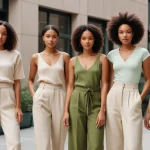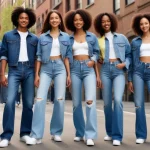Vintage & Secondhand Fashion: The Ultimate Women’s Guide
Shopping for vintage and secondhand fashion allows women to cultivate a unique personal style while making sustainable choices that benefit both their wardrobe and the planet.
Welcome to the captivating world of pre-loved garments! If you’re a woman looking to infuse your wardrobe with character, sustainability, and unparalleled style, then the ultimate women’s guide to shopping vintage and secondhand fashion is your essential starting point. This journey isn’t just about clothes; it’s about storytelling, conscious consumption, and discovering pieces that truly resonate with your individuality. Get ready to transform your approach to fashion!
Why embrace vintage and secondhand fashion?
Diving into the realm of vintage and secondhand fashion offers a plethora of benefits that extend far beyond simply acquiring new clothes. It’s a conscious decision that impacts your personal style, your wallet, and the environment. Understanding these motivations can deepen your appreciation for every pre-loved piece you discover.
One of the most compelling reasons is the unique style it offers. Unlike fast fashion, which often leads to everyone wearing similar trends, vintage pieces provide an opportunity to stand out. You’ll find garments with distinct cuts, fabrics, and embellishments that are no longer mass-produced, allowing you to curate a wardrobe that truly expresses your personality. Each item tells a story, carrying with it a piece of fashion history.
Sustainable style choices
Choosing secondhand is a powerful statement for sustainability. The fashion industry is a major contributor to pollution and waste, from water consumption to textile landfill. By opting for pre-owned items, you actively reduce your carbon footprint and extend the life cycle of clothing, preventing it from ending up in landfills. This conscious consumerism helps to mitigate the environmental impact of fashion production.
- Reduces textile waste and pollution.
- Minimizes demand for new production.
- Conserves natural resources like water and energy.
- Supports a circular economy model.
Furthermore, the quality of vintage clothing often surpasses that of modern fast fashion. Garments from decades past were frequently made with higher-quality materials and superior craftsmanship, designed to last. This means that a vintage piece, even if it’s decades old, can often outlast brand-new items, offering better value for money in the long run. Embracing vintage and secondhand fashion is not just a trend; it’s a lifestyle choice that champions individuality, sustainability, and enduring quality.
In essence, embracing vintage and secondhand fashion means consciously choosing unique style, environmental responsibility, and superior quality over the fleeting trends and disposable nature of fast fashion. It’s a rewarding journey that enriches your wardrobe and aligns with a more sustainable way of living.
Where to find your next vintage treasure
The hunt for the perfect vintage or secondhand piece is part of the thrill. Knowing where to look can significantly enhance your chances of finding true gems. From brick-and-mortar stores to online marketplaces, the options are more diverse than ever, catering to every preference and budget.
Local thrift stores and consignment shops are often the first stop for many vintage enthusiasts. These stores offer a wide array of clothing, often at incredibly affordable prices. The inventory changes constantly, so regular visits are key to discovering new arrivals. Consignment shops tend to be more curated, offering higher-quality items, but at slightly higher price points.
Specialized vintage boutiques
For those seeking more curated collections and specific eras, specialized vintage boutiques are invaluable. These shops often have knowledgeable staff who can help you identify authentic pieces and understand their historical context. While prices may be higher, the quality and uniqueness of the items are usually guaranteed. They are excellent places to find designer vintage or rare finds.
- Curated selections by era or style.
- Expert staff for authentication and advice.
- Higher quality and often rarer items.
- A more focused shopping experience.
Online vintage marketplaces have revolutionized the way we shop for secondhand items. Websites like Etsy, eBay, Depop, and Poshmark offer a vast global selection, allowing you to search for specific items, brands, or eras from the comfort of your home. Always check seller reviews and ask for measurements to ensure a good fit when shopping online. Social media platforms also host many vintage sellers, making it even easier to connect with independent curators.
Additionally, vintage fairs and flea markets are fantastic opportunities to explore a diverse range of vendors in one location. These events often feature sellers specializing in different vintage categories, offering everything from clothing and accessories to home goods. The atmosphere is usually vibrant and interactive, allowing for negotiation and direct interaction with sellers.
Ultimately, the best place to find your next vintage treasure depends on what you’re looking for and your preferred shopping experience. Whether you enjoy the thrill of the hunt in a thrift store or the curated selection of a boutique, there’s a perfect spot waiting for you to uncover unique fashion pieces.
Key considerations when shopping vintage
Shopping for vintage and secondhand clothing can be incredibly rewarding, but it also comes with its own set of considerations. Being prepared and knowing what to look for can make all the difference between a successful find and a regrettable purchase. It’s about developing a keen eye and understanding the nuances of older garments.
First and foremost, always inspect the condition of the garment thoroughly. Look for any tears, stains, missing buttons, or broken zippers. While some minor flaws can be easily repaired, significant damage might make a piece unwearable or require costly alterations. Pay close attention to high-stress areas like armpits, collars, and seams.
Understanding sizing and fit
Vintage sizing often differs significantly from modern sizing. A size 8 from the 1960s might be equivalent to a modern size 4, for example. Therefore, it’s crucial to ignore the tag size and instead rely on measurements. Always try on items if possible, or carry a tape measure to compare garment measurements with your own. Remember, a tailor can often adjust a slightly larger item, but making a too-small item fit is usually impossible.
- Ignore tag sizes; they are often outdated.
- Always try on garments or take measurements.
- Consider potential alterations for a perfect fit.
- Focus on how the garment feels, not just the number.
Fabric composition is another vital aspect. Vintage garments often feature natural fibers like wool, silk, linen, and cotton, which tend to be more durable and comfortable than many modern synthetics. However, some older synthetics can also be very high quality. Understanding different fabrics will help you assess the garment’s longevity, care requirements, and overall feel.
Consider the garment’s care instructions. Many vintage items may require delicate washing, hand-washing, or dry cleaning. Be prepared for this commitment to maintain the item’s condition. Also, be mindful of any lingering odors; while some can be removed with proper cleaning and airing, others might be more persistent. A good sniff test is never a bad idea!
By carefully considering condition, sizing, fabric, and care, you can make informed decisions when shopping vintage. This thoughtful approach ensures that each piece you bring into your wardrobe is a cherished and wearable addition.
Styling your vintage finds
Integrating vintage and secondhand pieces into your contemporary wardrobe is an art form that allows for endless creativity and personal expression. The goal isn’t to look like you’re wearing a costume, but rather to weave these unique items seamlessly into your modern style, creating cohesive and distinctive outfits.
One of the easiest ways to start is by mixing vintage with modern basics. A beautifully tailored vintage blazer can elevate a simple t-shirt and jeans. A classic vintage silk scarf can add a pop of color and sophistication to any outfit. This juxtaposition creates an interesting contrast that highlights the best of both worlds, making your vintage pieces feel current and fresh.
Accessorize with intention
Accessories are often the simplest entry point into vintage fashion. A vintage handbag, a statement necklace, or a pair of unique earrings can instantly transform an otherwise ordinary outfit. These smaller pieces are less about fit and more about adding character and a touch of historical charm. They can be conversation starters and reflect your individuality without overwhelming your look.
- Start with vintage jewelry or scarves.
- Use bags and belts to add a retro touch.
- Mix textures and patterns for visual interest.
- Let one vintage accessory be the focal point.
Don’t be afraid to experiment with layering. A vintage slip dress worn over a modern turtleneck, or a vintage vest over a contemporary blouse, can create unexpected and stylish combinations. Layering not only adds depth and warmth but also allows you to adapt pieces for different seasons and occasions, maximizing their versatility.
Consider tailoring and alterations. Even the most perfect vintage find might need a slight tweak to fit you perfectly. Investing in minor alterations, such as hemming a dress or taking in a waist, can make a significant difference in how a garment looks and feels on you. A well-fitting item always looks more expensive and intentional.
Ultimately, styling vintage finds is about personalizing your look. Trust your instincts, play with different combinations, and let your unique personality shine through. The beauty of vintage fashion lies in its ability to tell your story, one unique piece at a time.
Caring for your pre-loved garments
Owning vintage and secondhand clothing is a commitment to preservation. These items have already stood the test of time, and with proper care, they can continue to be cherished pieces in your wardrobe for many more years. Understanding how to maintain their integrity is crucial for their longevity and your enjoyment.
Always check the care labels, if they exist. Many older garments may not have modern care tags, or the tags might be faded. In such cases, it’s best to err on the side of caution. For delicate fabrics like silk, lace, or embellished items, hand washing in cold water with a gentle detergent is often the safest bet. Wool items should also be hand-washed or dry-cleaned to prevent shrinking.
Proper storage techniques
How you store your vintage garments significantly impacts their condition. Avoid hanging heavy knits or beaded dresses, as this can cause stretching or distortion; instead, fold them neatly. Use padded hangers for delicate items to prevent shoulder bumps. Ensure your closet is well-ventilated and free from direct sunlight, which can fade fabrics over time.
- Fold heavy or delicate items to prevent stretching.
- Use padded hangers for structured garments.
- Store in a cool, dry, dark place.
- Avoid plastic garment bags for long-term storage.
Consider using breathable garment bags for special or seasonal pieces. Avoid plastic dry cleaning bags, as they can trap moisture and chemicals, potentially damaging fabrics. Instead, opt for cotton or canvas bags that allow the fabric to breathe. Cedar blocks or sachets can help deter moths and keep garments smelling fresh, but ensure they don’t directly touch the fabric.
Address any minor repairs promptly. A loose button, a small seam tear, or a tiny hole can quickly worsen if left unattended. Learning basic mending skills or finding a reliable tailor can save your beloved vintage pieces from further damage. Regular inspection allows you to catch issues before they become major problems.
By investing a little time and effort into the proper care and storage of your vintage and secondhand clothing, you ensure that these unique pieces remain beautiful and wearable, extending their life and preserving their story for years to come. This attention to detail is a hallmark of a true vintage fashion aficionado.
The environmental and ethical impact
Beyond personal style and unique finds, shopping vintage and secondhand fashion carries profound environmental and ethical implications. It’s a powerful way for consumers, especially women, to make a positive impact on the world, shifting away from the damaging practices of the fast fashion industry.
Breaking the fast fashion cycle
Fast fashion thrives on rapid production, low prices, and constant turnover, encouraging consumers to buy more and discard quickly. This model leads to immense textile waste, with millions of tons of clothing ending up in landfills each year. Opting for vintage and secondhand items directly counters this cycle, promoting a more circular and sustainable approach to clothing consumption.
- Reduces demand for new clothing production.
- Decreases textile waste in landfills.
- Lessens the use of water, energy, and chemicals.
- Promotes a more conscious consumer mindset.
Ethically, secondhand shopping often means avoiding the problematic labor practices associated with fast fashion. Many new garments are produced in factories with poor working conditions and unfair wages, particularly in developing countries. When you buy pre-loved, you’re not directly supporting these exploitative systems, allowing you to dress with a clearer conscience.
Furthermore, supporting local thrift stores and vintage boutiques often means supporting small businesses and local economies. These establishments provide jobs and contribute to the community, unlike large fast-fashion corporations that often funnel profits out of local areas. It’s a way to invest in your community while also investing in sustainable fashion.
In conclusion, the environmental and ethical benefits of choosing vintage and secondhand fashion are undeniable. It’s a conscious decision that empowers women to dress beautifully, uniquely, and responsibly, contributing to a healthier planet and a more equitable fashion industry.
Building a sustainable vintage-inspired wardrobe
Building a sustainable, vintage-inspired wardrobe is a journey that combines mindful shopping with creative styling. It’s about curating a collection of pieces that are not only unique and stylish but also stand the test of time, reflecting both your personal aesthetic and your commitment to sustainability.
Start by identifying your personal style and the eras that most appeal to you. Do you love the flapper dresses of the 1920s, the tailored silhouettes of the 1950s, or the bohemian vibes of the 1970s? Having a clear vision will help you focus your search and avoid impulse purchases. Create a mood board or a Pinterest board to visualize your ideal wardrobe.
Invest in versatile staples
When building your vintage-inspired wardrobe, prioritize versatile staple pieces that can be mixed and matched to create numerous outfits. A classic vintage trench coat, a well-fitting pair of vintage jeans (if you can find them!), or a timeless silk blouse can form the foundation of many looks. These pieces are often made with superior quality, ensuring they remain in your wardrobe for years.
- Identify your preferred vintage eras.
- Focus on versatile, high-quality pieces.
- Mix and match for diverse outfits.
- Prioritize items that reflect your personal style.
Don’t be afraid to incorporate modern pieces to complement your vintage finds. A contemporary pair of shoes or a modern bag can update a vintage dress, making it feel less costume-like and more integrated into current fashion. The key is balance and creating a harmonious blend between old and new.
Finally, embrace the art of slow fashion. Rather than constantly chasing trends, invest in pieces you truly love and that will bring you joy for a long time. This approach not only results in a more sustainable wardrobe but also one that is deeply personal and reflective of who you are. Building a vintage-inspired wardrobe is a continuous process of discovery, creativity, and conscious choice.
By thoughtfully selecting, caring for, and styling your vintage and secondhand items, you can build a sustainable, unique, and truly inspiring wardrobe that expresses your individuality and values.
| Key Aspect | Brief Description |
|---|---|
| Unique Style | Discover one-of-a-kind pieces that truly express your individuality, avoiding mass-produced trends. |
| Sustainability | Reduce your environmental impact by giving clothes a second life and lessening demand for new production. |
| Quality & Value | Often find higher quality fabrics and craftsmanship that offer better longevity and value than fast fashion. |
| Smart Shopping | Learn tips for inspection, sizing, and care to make informed purchases and preserve your finds. |
Frequently Asked Questions about Vintage Fashion
Generally, ‘vintage’ refers to items that are at least 20 years old but less than 100 years old, often associated with a specific era’s style. ‘Secondhand’ is a broader term for any pre-owned item, regardless of age, usually implying it’s been previously worn or used.
Vintage sizing is inconsistent with modern standards. Always ignore the tag size and rely on actual garment measurements. Measure your body and compare it to the item’s dimensions for the best fit. Trying on is ideal, but a tape measure is your best friend when thrifting.
Carefully check for stains, tears, holes, missing buttons, and broken zippers. Examine seams for integrity and look at high-wear areas like armpits and collars. Consider if any flaws are repairable or if they compromise the garment’s wearability.
Yes, it is generally hygienic. Most reputable sellers clean items before selling. However, it’s always recommended to wash or dry clean any secondhand garment before wearing it for the first time. This ensures freshness and cleanliness, just as you would with new clothes.
Mix vintage pieces with modern basics like jeans, plain t-shirts, or contemporary shoes. Use tailoring to update silhouettes, and accessorize thoughtfully with current trends. The key is to create a balanced look where vintage elements enhance, rather than dominate, your overall style.
Conclusion
Embarking on the journey of shopping vintage and secondhand fashion is more than just updating a wardrobe; it’s an embrace of individuality, sustainability, and quality. As we’ve explored, this guide empowers women to navigate the exciting world of pre-loved garments, offering practical insights into finding unique pieces, understanding their value, and caring for them properly. By choosing vintage, you’re not only curating a distinctive personal style but also making a conscious choice to reduce your environmental footprint and support a more ethical fashion industry. So go forth, explore, and let your style tell a story that’s uniquely yours.




